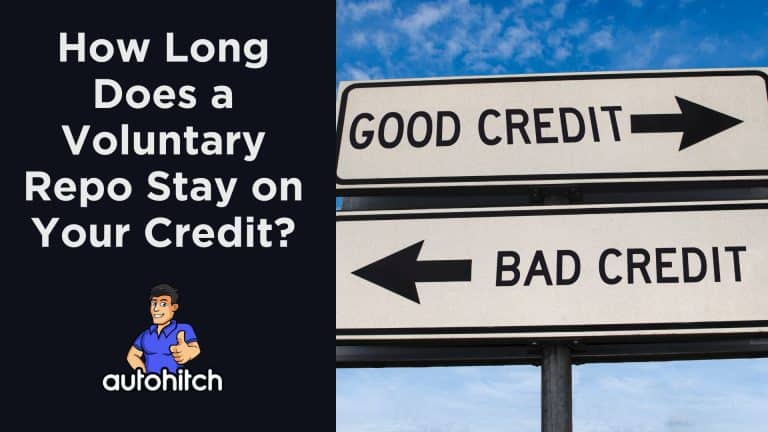When you face car payments that just aren’t manageable anymore, you might consider voluntarily surrendering your vehicle to the lender.
This process, known as voluntary repossession or voluntary surrender, can seem like a better alternative to having your car involuntarily repossessed.
However, it’s important to understand the potential consequences of this route, particularly its impact on your credit score and future financial future.
| Impact | Description |
|---|---|
| Credit Report | Voluntary repossession appears on your credit report for up to 7 years from the date the loan initially became delinquent |
| Credit Score | Expect a substantial drop in your credit score, often around 100 points or more |
| Future Loans | Lenders may view you as a higher risk, making it more difficult to secure new loans or credit |
Table of Contents
Related Articles To Read:
- How to Get a Repo Off Your Credit Report
- Car Repossession Loopholes
- What Happens If You Hide Your Car From Repossession
- How Does The Repo Man Find Your Car
- Car Repossession Laws By State
What is Voluntary Repossession?
Voluntary repossession occurs when a borrower returns their vehicle to the lender due to an inability to make loan payments BEFORE the lender has the opportunity to repo it by force.
In this case, the borrower initiates the process by informing the creditor of their intention to surrender the vehicle.
The voluntary repossession process typically involves the following:
- Contacting the lender to discuss your situation and intention to surrender the vehicle
- Arranging a time and place for the lender or a repossession company to take possession of the car
- Removing personal belongings and returning the vehicle keys
- Signing necessary documents acknowledging the voluntary surrender
It’s important to note that there is little difference in the credit impact between voluntary and involuntary repossession. Both are reported as a repossession and can severely damage your credit standing.
Pros and Cons of Voluntary Repossession
| Aspect | Pros | Cons |
|---|---|---|
| Emotional Impact | – Avoids the stress and embarrassment of involuntary repossession- Allows for a more controlled and predictable process | – Feelings of failure or defeat- Emotional toll of giving up the vehicle |
| Credit Score | – Slightly less damaging than involuntary repossession- Demonstrates willingness to work with creditors | – Significant negative impact, often around 100 points or more- Remains on credit report for up to 7 years |
| Financial Obligations | – May help avoid additional costs associated with involuntary repossession, such as towing and storage fees | – Potential deficiency balance if the vehicle sells for less than the outstanding loan amount- Failure to pay the deficiency balance can lead to collections or legal action |
| Future Borrowing | – Proactive approach may be viewed more favorably by some lenders compared to involuntary repossession | – Difficulty securing new loans or credit due to the negative credit impact- Higher interest rates if approved for credit |
| Legal Consequences | – Reduces the risk of breaching the peace during an involuntary repossession- May provide an opportunity to negotiate with the lender | – Potential legal action if the deficiency balance is not paid- Lender may still pursue a deficiency judgment |
| Vehicle Retrieval | – Allows for a more organized and convenient surrender of the vehicle | – Typically no option to reclaim the vehicle once surrendered- Losing transportation can impact daily life and employment |
Potential Financial Obligations After Voluntary Repossession
Surrendering your vehicle voluntarily does not erase your debt.
The lender will typically sell the car at auction to recover as much of the outstanding loan balance as possible.
Important Fact: The problem is that you paid retail for the car, and auctions are dealers bidding at wholesale prices.
If the sale price is less than what you owe (Which it usually is from my years at auction), you may be responsible for paying the deficiency balance.
Here is an example of having to owe money after the lender sells your vehicle:
- Outstanding Loan Balance: $15,000
- Auction Sale Price: $10,000
- Deficiency Balance: $5,000
Failure to pay the deficiency balance can result in the lender sending your account to collections or even filing a lawsuit against you, leading to further credit damage.
Voluntary Repossession with No Missed Payments
If you voluntarily surrender your car when you’ve never missed or were late for a payment, it may seem like that shouldn’t harm your credit.
However, regardless of the circumstances, a voluntary repossession will be reported to the credit bureaus and will negatively impact your credit score.
Here are a few key points to consider:
- Lenders view voluntary repossession as a default on the loan agreement, regardless of your previous payment history.
- The repossession will be noted on your credit report and can lower your credit score by up to 100 points or more.
- Potential lenders will see the voluntary repossession on your credit report and may be hesitant to approve you for new credit or loans, even if you had a perfect payment history before the surrender.
You might try to arrange a sale of the car before giving it back to the lender. This gets you more money and makes it morel likely you can get out of the car owing no money.
Helpful Article to Read: Can I Sell My Car Without a Title
Alternatives to Voluntary Repossession
Before proceeding with voluntary repossession, explore alternative options:
- Loan Modification: Contact your lender to discuss potential loan modifications, such as extending the loan term or temporarily reducing payments.
- Refinancing: Investigate refinancing your auto loan to secure a lower interest rate and more manageable monthly payments.
- Selling the Vehicle: Consider selling your car privately to pay off the loan balance and avoid repossession altogether.
- Bankruptcy: If you’re facing overwhelming debt, consult with a bankruptcy attorney to discuss whether Chapter 7 or Chapter 13 bankruptcy could provide relief and help you keep your vehicle.
Related Articles To Read:
- Can I file For Bankruptcy And Keep My Car
- How Soon After Bankruptcy Can I Buy a New Car
- Chapter 13 Dismissed How Long Before Repo
Rebuilding Credit After Voluntary Repossession
If you proceed with voluntary repossession, the very next thing you should do is take steps to rebuild your credit:
- Make timely payments on all remaining credit accounts
- Keep credit card balances low to maintain a favorable credit utilization ratio
- Consider secured credit cards or credit-builder loans to establish a positive payment history
- Regularly review your credit reports for accuracy and dispute any errors
Remember, while voluntary repossession has a significant negative impact on your credit, recovery is possible over time through consistent, responsible credit management.
Read: Helpful Article on Repairing Credit.
Key Takeaways
- Voluntary repossession involves proactively returning your vehicle to the lender when unable to make loan payments
- Both voluntary and involuntary repossession can severely damage your credit, remaining on your credit report for up to 7 years
- You may still be responsible for paying any deficiency balance after the vehicle is sold at auction
- Voluntary Repossession still hurts your credit even if you never missed a payment
- Explore alternatives like loan modification, refinancing, private sale, or bankruptcy before proceeding with voluntary repossession
- Rebuilding credit after voluntary repossession is possible through timely payments, low credit utilization, and establishing a positive payment history
Sources For This Article
- https://upsolve.org/learn/advantages-to-voluntary-repossession/
- https://www.bankrate.com/loans/auto-loans/when-is-a-car-loan-too-old-for-collection/
- https://www.moneylion.com/learn/how-to-remove-repossession-from-credit-report/
- https://www.reddit.com/r/personalfinance/comments/17udsb6/what_happen_after_voluntarily_repo_finance_car/



